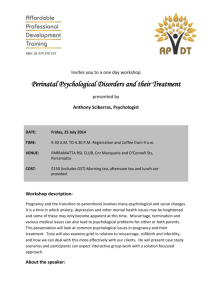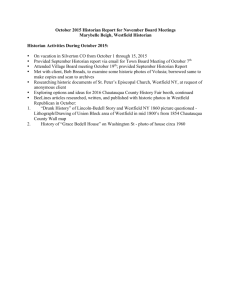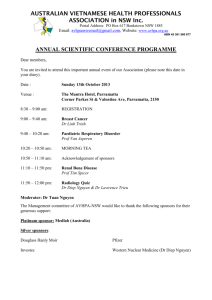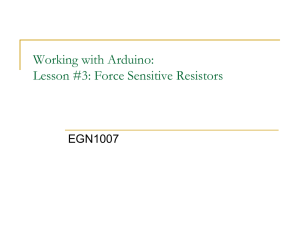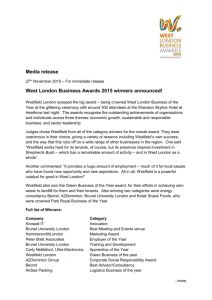Minutes of Half Day Session held 13 June 2007
advertisement
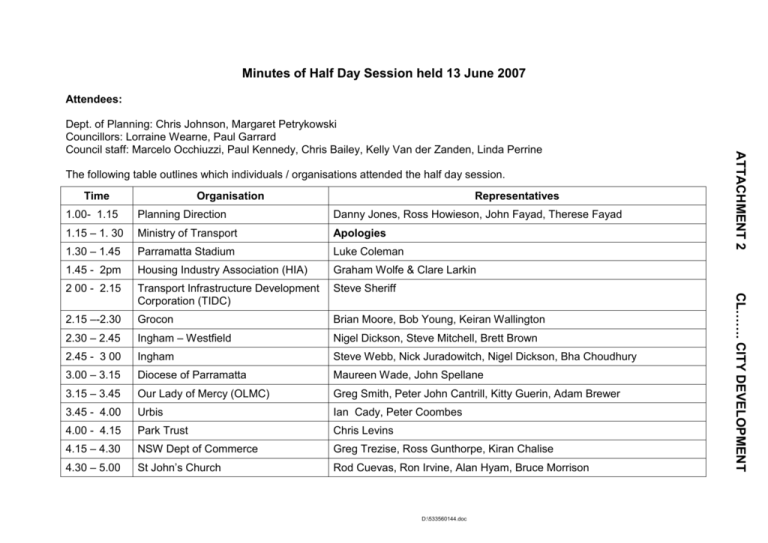
Minutes of Half Day Session held 13 June 2007 Attendees: The following table outlines which individuals / organisations attended the half day session. Time Organisation Representatives Planning Direction Danny Jones, Ross Howieson, John Fayad, Therese Fayad 1.15 – 1. 30 Ministry of Transport Apologies 1.30 – 1.45 Parramatta Stadium Luke Coleman 1.45 - 2pm Housing Industry Association (HIA) Graham Wolfe & Clare Larkin 2 00 - 2.15 Transport Infrastructure Development Corporation (TIDC) Steve Sheriff 2.15 –-2.30 Grocon Brian Moore, Bob Young, Keiran Wallington 2.30 – 2.45 Ingham – Westfield Nigel Dickson, Steve Mitchell, Brett Brown 2.45 - 3 00 Ingham Steve Webb, Nick Juradowitch, Nigel Dickson, Bha Choudhury 3.00 – 3.15 Diocese of Parramatta Maureen Wade, John Spellane 3.15 – 3.45 Our Lady of Mercy (OLMC) Greg Smith, Peter John Cantrill, Kitty Guerin, Adam Brewer 3.45 - 4.00 Urbis Ian Cady, Peter Coombes 4.00 - 4.15 Park Trust Chris Levins 4.15 – 4.30 NSW Dept of Commerce Greg Trezise, Ross Gunthorpe, Kiran Chalise 4.30 – 5.00 St John’s Church Rod Cuevas, Ron Irvine, Alan Hyam, Bruce Morrison D:\533560144.doc CL……. CITY DEVELOPMENT 1.00- 1.15 ATTACHMENT 2 Dept. of Planning: Chris Johnson, Margaret Petrykowski Councillors: Lorraine Wearne, Paul Garrard Council staff: Marcelo Occhiuzzi, Paul Kennedy, Chris Bailey, Kelly Van der Zanden, Linda Perrine Issues Raised Planning Direction (PD) 1. The site at 39-41 Hassall Street. The submission is for an increase in height from 54m to 72m along the corridor with an FSR of 8:1.adjoining the park. 2. The site bounded by Kendall and Parkes Streets. The draft LEP indicates a 28m height limit, but the proposal is for a 40m height limit with an FSR of 6:1. 2. Kendall and Park Street Block The submission outlined that the 40m height limit proposed in officer’s report was welcome, however, the FSR proposed of 4:1 was not possible to be achieved on the site as the landowner’s modelling demonstrated. This should be 6:1. There is a difference in the methodology of the calculation of FSR between the REP and the draft LEP and this should be taken into account. Similarly, staff have reviewed the submission relating to item 2 and considered a height and FSR increase in line with the zone being changed to commercial core. Whilst staff previously supported this change, it is the DoP’s intentions not to rezone these blocks. Council staff contend that the recommended increased height and FSR to the block bounded by Parkes, Station Street East and Kendall Streets should only occur if it is rezoned. The risk is that the Department will reject the rezoning of the block(s) and maintain the increased development capacity. This would be undesirable as the amenity of the area is not particularly conducive to residential development. Therefore, it will is the recommendation of this report that the controls remain as exhibited. D:\533560144.doc CL……. CITY DEVELOPMENT 1. Hassall Street It was submitted that the site was in reasonable proximity to the railway station with a flat walk. There is no reason why the land should not accommodate increased development potential given the need to accommodate optimistic growth projections. Response Council staff have reviewed the submission and maintain that the development potential of the Hassall Street property should not be increased. The 54 metre height limit represents a significant increase form current height controls in the REP. It represents a “hard edge to the park, however, a 72m edge is considered overwhelming and not desirable. ATTACHMENT 2 Issue Danny Jones (PD) made representation regarding two areas on the eastern edge of the City Centre. They are Parramatta Stadium Response The stadium was included in the draft Plan. The stadium is zoned Private Recreation and under Schedule 1 Additional Permitted Uses there are provisions which reflect the unique characteristics of the site -- these are carried over from the REP. The stadium is not subject to any specific height or floor space ratio controls and development proposal can be evaluated on their merits. It was submitted that the stadium was not considered for “funding” by The purpose of the CIP is to fund public infrastructure the Council, unlike the adjacent $25 million upgrade of the Olympic pool and facilities. The Parramatta Stadium does not fit this in the Civic Improvement Plan (CIP). category. Transport Infrastructure (TIDC) . Issue Zoning across allotments Issue with splitting zoning across land in their ownership along the railway corridor (Lot PT 204, DP 1083102). Under the Draft Zoning Plan, most of the land is zoned B3 Commercial core and part B4 Mixed Use. TIDC is seeking to achieve a consistent zoning of B4 Mixed Use across their entire subdivision. Reasons for the request is that land is part of a divestment Response It is agreed that the site should have a common zone given especially that the “road” shown on the maps no longer exists. This site is recommended to be zoned Commercial Core given its strategically significant location adjacent to the railway station. D:\533560144.doc CL……. CITY DEVELOPMENT It was noted that there could be closer ties between Parramatta Park and the Stadium. ATTACHMENT 2 Issue Luke Coleman expressed the point that the Parramatta Stadium had been “excluded” from the “Grand Plan’ for Parramatta. He maintained that the stadium was a real part of the business community and should be more closely integrated into the fabric of the growing city. ATTACHMENT 2 strategy for Public Transport Interchange and because if considered appropriate in the future, would allow for some residential in close proximity to the railway line. TIDC’s submission highlights the historical context of the allotment in an aerial photo which provides view of allotment arrangements TIDC is not looking for any height adjustment – the sight is affected by the sun access plane There is not current proposal for a residential development. There was recognition that when development occurs on the site, further thought and detailed work needs to be done on ensuring a good public space and appropriate pedestrian through links. It was agreed that the rate of parking should be expressed as a maximum not minimum as this has wide transport planning implications. Calculation of FSR TIDC made specific reference to Lot 205 of their property portfolio which currently functions as a pedestrian connection. Whilst TIDC has no objection to retaining or enhancing the connection, it seeks some reconciliation of the loss of floor The point made is appreciated but will require modification of the provisions of the standard LEP template. D:\533560144.doc CL……. CITY DEVELOPMENT Minimum car parking requirement TIDC feels that the proposal to establish the car parking rates as a minimum does not recognise the site’s proximity to public transport nor encourage reduced use of the vehicle. TIDC would prefer a Maximum rate be expressed. It was also noted that if a developer was required to provide increased numbers of car parking, this had further complications and limitation in Parramatta due to archaeological constraints and the water table. space potential. Specifically the way in which it is calculated. TIDC suggested that where an area provides some public benefit it should not be excluded from the total floor area for the purposes of calculating FSR. Response The levy was in direct response to the significant increase in development potential and floor space and the subsequent impact upon infrastructure and services. The State Government is still in the process of providing for a uniform approach to affordable housing throughout Sydney. D:\533560144.doc CL……. CITY DEVELOPMENT Issue The major concern of the HIA relates to infrastructure levies, specifically the potential for inclusionary zoning rights relating to affordable housing, housing mix and accessible housing. The 3% levy will impact upon cost of residential construction and therefore flow through to the provision of affordable housing, specifically, reduce it. HIA was seeking an opportunity to have a variable levy for residential development over others? HIA feels that Councils have a role to play in the argument to support affordable housing and should be entering the debate on this matter. HIA suggested that by recognising affordability as an issue (by allowing a mechanism built into the levy for provision of affordable housing) will keep the issue on the agenda and ensure that measures are taken to try and provide this type of housing throughout Sydney. ATTACHMENT 2 Housing Industry Association Grocon Response It is agreed that the alignment of the 200m height limit was incorrectly drafted as exhibited. This will be amended in accordance with the Civic Place Masterplan. As discussed above, the carparking rates are proposed to be changed to maximum rather than minimum. Issue The main issue for Westfield is that it feels that it has been sidelined as part of the City Plan process and this has been based on history particularly relating to urban form issues. Westfield wanted to reiterate that their philosophy and approach toward development was moving forward and is particularly focused on urban design issues. Examples were given of their Response It was noted that while the example of Guildford in the UK was a good one, the options presented for Parramatta to date, seemed to lack the critical mixed use elements an represented a bulky and “closed” approach that Council was trying to avoid. D:\533560144.doc CL……. CITY DEVELOPMENT Westfield ATTACHMENT 2 Issue Grocon raised the issue of the configuration and alignment of the 200m height line affecting Civic Place, specifically its alignment along the rear of the existing allotments which face Darcy Street. Grocon is seeking adjustment of this alignment in order to reflect the objectives of the Civic Place Masterplan, which will reflect the alignment of the facades of the new building footprints and allow for the appropriate bulk and massing. Grocon is not looking for any changes to the FSR or philosophy etc, but rather just wants refinement of the fundamental design principles. Any other issues put forward on behalf of Grocon by Vivian Goldsmith in JBA’s original submission to the Plan, are more just a matter of semantics. Notwithstanding, one issue that Grocon saw as an important issue for concern was the proposal for a minimum car parking rate, particularly as prohibitions have already been placed on their site. There is a strong desire for permeability and that Westfield would need to consider these issues to avoid the “box” status of the site in the CBD which seeks to capture shoppers and keep them within for as long as possible. It was expressed that Council was keen for positive design options to occur on the site and was in principle supportive of a collaborative approach to Westfield’s redevelopment, but in a measured manner. It was suggested that a collaborative planning process could lead to a future amendment in the planning documents for the City Centre. CL……. CITY DEVELOPMENT ATTACHMENT 2 new approach to development and precedents in Guildford, Nottingham and London in the UK, Belfast in Ireland and Bondi Junction in Sydney, were presented. Westfield reiterated that it is keen for a mixed use development approach and in the case of Parramatta, this would compensate for exposed car parking and floor space issues. The general position of Westfield is to change its built form appearance over time but have not been given that opportunity to do so under the limited control framework as proposed by the City Plan. Westfield feels that from a planning perspective, there has been inequity in the process of development the City Plans and they have been excluded from the process, especially considering its strategic location and their willingness to do something different. Westfield feels that because of the sites strategic role and location within the city, especially its proximity and relationship to the railway that if the site does not have the potential to improve and develop this will be to the detriment of the whole city. It was mentioned that the matter of above ground car parking and its inclusion as floor space for the purposes of calculating FSR, restrict Westfield from doing things to the site. Westfield raised the issue that it believes there was inconsistency in the application of the state government directive to exclude car parking from FSR. Westfield further explained some of their design theories for Parramatta’s site and noted that they would likely need an FSR of about 8:1 to achieve their design objectives and even 10:1 if above ground car parking was included as FSR. D:\533560144.doc 89 George Street (Better Brakes) Response It was acknowledged that some thought had been given to a review of these words which are proposed to be amended. It was noted that it was difficult for the entire suite of controls to capture all situations in the city and that there are some circumstances where variations could be considered. Relating to this, there was discussion about the application of Clause 24 of the LEP for this purpose. Issue Draft LEP had no height limit for the site. Intention was to include an overlay of a masterplan that was approved by the Heritage Council. The area of the oval should be zoned open space and agree with officer’s recommendation that this should be so zoned. Response It is proposed that the LEP height limit be changed to 10 metres for land generally north of the oval and 18 metres for the north western corner of the site. Furthermore, an additional height overlay is proposed for the DCP in accordance with the approved masterplan for the site. D:\533560144.doc CL……. CITY DEVELOPMENT Diocese of Parramatta ATTACHMENT 2 Issue The main concern for this developer was the impact of Clause 22A for minimum lot frontages and its limitation on the site. The point was made that Clause 22A does not include objectives which consequently makes it difficult to justify a variation on the standard. Further, that the words “physically not possible” are limiting and should be reviewed. In addition, concern was expressed for the penalty on small lots in respect of FSR and the difficulty to get consistent built form. It was suggested that it may be more appropriate to have a sliding scale approach for smaller sites. In respect of the indicative pedestrian links there is concern that the provision of these on small sites could impose a penalty or further constraint to development. It was suggested that where a developer was required to provide pedestrian access, particularly on such a constrained site, there should be a floor space bonus or different method for calculating FSR. Something equivalent to the amount of land excluded for that purpose for example. Our Lady Of Mercy (OLMC) Issue Want to be included within City Centre Plan boundary as it is a regional school and the boundary of the city centre does not seem to make sense as it seems to intentionally work around the site. Total of approx. 1,500 people on the site including teachers and students. School need to expand, including playground area. Traffic issues associated with “busy-ness” of the area. Potential overshadowing from adjoining development, this is not yet known. Transport issues as most students arrive by public transport from long distances. Privacy for girls. Traffic – Victoria Road, Ross Street and possibly Villiers Street needs attention but perhaps this is outside of the LEP. The boundary of the city centre is based on the REP and this will remain at this stage. This may be reviewed in the future. The traffic management issues associated with the location of the school are issues that should be taken up as part of Council operational traffic management service rather than the plan making process. There may be some minor overshadowing of the school site in early morning times, however, the school should generally have good levels of sun access throughout the year. Privacy for the girls of the school may be provided as part of any future masterplan for the school. D:\533560144.doc CL……. CITY DEVELOPMENT Response ATTACHMENT 2 It was outlined that open space would infer responsibility of purchase by Council and the report had an anomaly in that one part referred to this site as being proposed for open space zoning and another part included the proposal to impose a “cross hatched” area, which also prohibits development. It was the intention to include a cross hatched area rather than open space zone. Parramatta Park Trust Response Acknowledges inputs to date and notes recommendations of officer reports and the shift in opinion on views. Trust acknowledges city is changing and understands its imperatives. As explained in the Council report of 30 May 2007, the views as exhibited, are proposed to be embellished (by the addition of significant REP views). It should be noted that as a planning authority, both Council and the Department of Planning need to balance the growth of the city in its historical context as well as within the wider metropolitan context. Heights on edge of city important, as are the setting of Park and the potential to appreciate its 19 century history. It is proposed to recognise the Park as a World Heritage site. Concerned about recognition of views in exhibited plan and the significant increase of height in the city core, N. Church St., the removal of views and the loss of setting for the Park. CL……. CITY DEVELOPMENT Key views explained: Views to N. Church St. now improved, but queried whether height is absolute. The Mays Hill views proposed are acceptable. Views from the Park to the city are compromised Views from The Crescent to Old Government House generally acceptable, but there will be higher buildings in the background ATTACHMENT 2 Issues The Park Trust is looking for robust controls and noted that court cases have defended views in the past. D:\533560144.doc Ian Cady and Peter Coombes Issue Response Concerned about 244 Church St., part of which fronts George Street. The floor space ratio has been reduced from 5: 1 to 3: 1, even though it is allowed a generous height under the sun access plane provisions. It is agreed that the floor space ratio should be increased to 10:1 in line with the change in height on the height map. Issue Regarding the Marsden site the word ‘revised’ should be omitted from the revised master plan guidelines. These have been given statutory weight in the LEP but should only be treated as guidelines. An 18 m height restriction should be allowed for development at the north western corner of the Marsden site and master plan guidelines should be included in the DCP. The floor space ratio for the whole site is appropriate and should also include the oval. The revised height limit for the Justice Precinct is acceptable but queried the 18 metres setback on O'Connell Street. A consistent setback is sought along Parramatta River and O'Connell Street. It is agreed that the adopted masterplan for the Marsden site should be treated as a guideline. Given that the heritage of the site is of state significance, this should be the significant control for the site. The masterplan will be a reference document to be referred to by the DCP. The comments regarding the Justice precinct are noted and a consistent setback will be proposed along the river and O’Connell Street. St Johns Cathedral precinct and adjoining land Issue Concerned about two areas: land to the north of the Church precinct known as Fund land and the Church precinct itself. Response It is agreed that the height limit of the “Fund” land should be increased to 18 metres in keeping with the pattern of height in the locality. D:\533560144.doc CL……. CITY DEVELOPMENT Response ATTACHMENT 2 NSW Department of Commerce The provisions of the SP2 Infrastructure Zone covering the Church precinct will be widened in line with LEP 2008 to give the Church additional flexibility in the use of it’s property. ATTACHMENT 2 83 Macquarie St. -- Rod Cuevas Issue The site of the native institution for Parramatta was formerly (in the mid19 century) situated at this address, as based on evidence prepared for a development application. This evidence will be submitted to Council Response This is noted. D:\533560144.doc CL……. CITY DEVELOPMENT Fund land: Noted that the Church's submission was favourably considered and that changes have been recommended, including increased height for Marsden Street of 36 metres. This was considered to be a good outcome. However, there was a disparity in this height and that of the block to the south east. The height of land should be increased to 24 metres (or 18 metres). Some concern was raised at the shadow effect of this height on heritage items. However, this height was considered to be within the existing shadow profile. Church precinct: There is a problem of use with the Verger’s cottage in the south western part of this precinct. The infrastructure zoning for the cottage is too restrictive and should be included in the same zone as adjoining land to the west. Similarly, the zoning of the hall in the north western part of the precinct is restrictive and a more flexible zone is sought allowing a wider range of uses including conference facilities. Height can be assessed on a merit basis. Concerned that site provisions allow the ability to subdivide.


